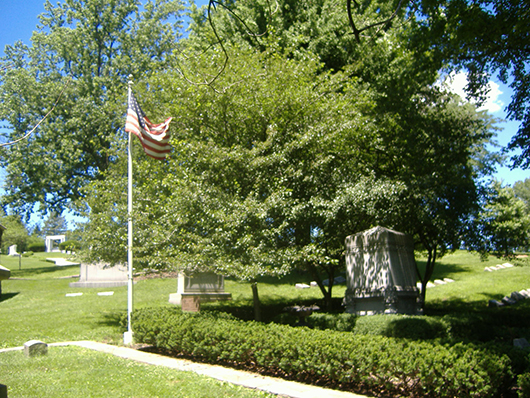
Made of walnut, covered in black broadcloth and lined in white satin, the box went on display Sunday at a 19th-century Gothic building at Crown Hill Cemetery and Funeral Home called the Waiting Station. The coffin’s limited five-day run ends Thursday.
A coffin is not exactly mainstream entertainment, but on opening day, which featured a performance by Lincoln impersonator Danny Russel, the Lincoln replica drew some three-dozen people. Since then the curious have trickled in steadily, such as David Owens of Greenwood. He was there Monday with his wife, Sherrie.
Owens is a Civil War buff and knows Lincoln. And as a Methodist minister, he has seen a coffin or two.
The Lincoln coffin, with its series of rivets pounded into its sides, struck him as too jazzy.
“Like something Elvis would be buried in, not Lincoln,” he told The Indianapolis Star.
But the coffin was, well, dead-on, built by Indiana’s Batesville Casket Co., the nation’s largest casket maker, to specs gained from an Illinois museum.
Owens walked around the coffin, photographed it and wondered about the silver handles. “Would these tarnish?” he asked.
“Oh, I bet they would,” said Mike Moffitt, Crown Hill’s director of funeral operations, who was on hand not to sell grave plots, but rather for long-term customer cultivation.
Marketing is done delicately in the death industry.
“Funerals and cemeteries are the thing nobody wants to talk about but that everyone eventually needs,” said Abigail Quiocho, Crown Hill’s director of business development.
The Lincoln coffin is one of four replicas that since the early 1990s have toured funeral homes across the country, drawing people who are not mourning and thus may be more approachable. The program is the brainchild of the Indiana casket maker, which loans out the Lincolns to funeral directors at no charge.
In recent years, casket sales have trended down as cremation has gained popularity. In 2011, 42 percent of the deceased were cremated, according to the National Funeral Directors Association, twice the rate 15 years ago.
But Batesville caskets, even with so much at stake, remain decorous. In 2009, when Michael Jackson was laid out in one of the company’s top-of-the-line Promethean models, Batesville sent out not a single news release. A company representative, when pressed, told The Indianapolis Star: “We never discuss any particular business transaction, but based on the images we saw on television, it appears to be a Promethean.”
The traveling Lincoln coffins, Batesville spokeswoman Teresa Gyulafia said, are “public relations, not marketing.”
“This is just a way to engage the community. People like historical things.”
Typically, demand for the coffins peaks in February for President’s Day, Gyulafia said. Next year, because it’s the 150th anniversary of Lincoln’s assassination, all four are booked solid the entire year.
Obviously, for most people it’s easier to talk about Lincoln’s death than their own. But talking about Lincoln’s “could spark discussion within a family” about their own final arrangements, said Curtis Rostad, executive director of the Indiana Funeral Directors Association. And it’s possible that seeing Lincoln’s casket could tip a family from cremation to burial, in which case the industry would benefit.
But “mostly it’s community service,” Rostad said. “It’s a way to get people to come by their facility and get acquainted with what they do. Any business benefits from doing something that draws people’s attention.”
Other heroic Americans have been buried publicly, such as John F. Kennedy, but from the funeral director’s perspective, Lincoln is special. He was the most conspicuous example of great advances in embalming that came about during the Civil War.
Lincoln died April 15, 1865, the day after he was shot, but it was May 4 before he was put in the ground. In the three-week interim, he was seen by hundreds of thousands of people, his funeral train stopping in 11 cities on its way from Washington to Springfield, Ill. Lincoln’s coffin was opened at each stop.
The funeral train arrived in Indianapolis April 30, 16 days after Lincoln had breathed his last. According to a historical marker Downtown, “some 50,000 people viewed Lincoln’s open casket.”
Lincoln’s coffin is “a relic of our past,” said Rostad, but the handling of his death represented “the time modern funeral practices, to a great extent, began.”
In the Waiting Station, on a card table near the Lincoln coffin, Crown Hill staffers had placed some handouts, including an Abraham Lincoln fact sheet with 50 facts. Before he was president, Lincoln argued a case before the Supreme Court and lost. His shoe size was between 12 and 14. Grave robbers tried to steal his body in 1876 but failed.
Owens, who often jogs through Crown Hill with his wife, got to thinking about mortality and said that it was important that a deceased person’s survivors have “a place to go” to remember the departed.
But that didn’t necessarily mean a hole in the ground. He himself planned to be cremated and have his ashes spread in Crown Hill’s “scattering garden,” a wooded section of the cemetery.
“It’s a very pretty place,” he said.
___
Information from: The Indianapolis Star, http://www.indystar.com
Copyright 2014 Associated Press. All rights reserved. This material may not be published, broadcast, rewritten, or redistributed.
AP-WF-10-01-14 1358GMT
ADDITIONAL IMAGE OF NOTE



